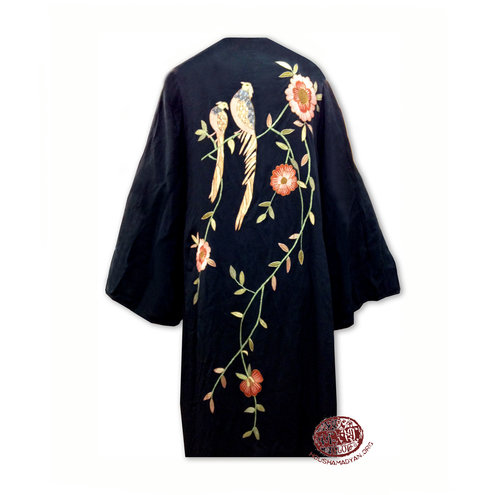
The silk robe of the Armenian woman from Ayntab: made in China or inspired by Chinese art?
by Ani Margaryan
The items in the Baghdasarian-Melkissetian collection once belonged to Lena Baghdasarian-Melkissetian’s grandmother, Lioni Nalbantian, are of great interest to the art researchers.
It is known, that Lena Baghdasarian was married in Ayntab to Simon Nalbantian who was a farrier. They immigrated from Ayntab to Aleppo at the beginning of the 20th century (before the Armenian Genocide) and later, in 1972, they moved to Lebanon. The collection is currently in the possession of Lena Baghdasarian-Melkissetian in Lebanon.
Among the collection as a part of her dowry, there was the current open front robe, made of black silk. According to the description in the primary source, the embroidery depicting flowers on the front and a huge collage of birds and flowers on the backside is said to be inspired by the Armenian traditional embroidery of Urfa.
However, the iconic flower of Urfa/Ourfa needlework does not have long branches and widely-opened petals. Besides, the pair of birds sitting on the branch interpreted through the naturalistic approach is not common for the embroidery school of Urfa.

Interestingly enough, the formal properties of those avian motifs, their arrangement throughout the compositional space in that way, and the pairing of them with those flowers is typical for Chinese century-old ink wash painting and not only.
Bird-and-flower painting (in Chinese 花鸟画) is a kind of Chinese painting prevalent in East Asia named after its subject matter. Normally, most bird-and-flower paintings belong to the scholar-artist style of Chinese painting, proper for the 10th-century Chinese culture. The most representative artists are Huang Quan 哳㥳 (c. 900 – 965) and Xu Xi 徐熙 (937–975). This type of Chinese oeuvre had a huge impact on the imagery of Chinese embroidery, ceramic decorations, porcelain themes, postcards, and printed products, is regarded as one of the most warmly-received themes for its vigorous scene and symbolic value. The major motif was two birds standing over the branches of the plum or chrysanthemum blossom, communicating with each other through gazes and gestures, indicating auspicious meanings linked with the idea of spring, love, good fortune, still remaining a beloved subject in Chinese culture.


Returning to the black robe of the Armenian woman, relying on its shape and formal qualities, particularly wide sleeves, it resembles the style of the Japanese kimono. At the time of flourishing Japonisme, it was a favorable item for the female toilette both in Europe and in the Middle East. The blossomed branch is more reminiscent of the chrysanthemum motifs of Chinese painting and embroidery. The pair of birds with their visual appearance also have parallels in Chinese art.
Taking into account the multicultural environment of Lebanon and the fact that its location makes it a vital crossroads between East and West in the sense of international commerce, the existing influence of Chinese or Japanese textiles and applied art at large seems quite appropriate. Since there isn’t any information concerning the origin of the present black robe, at this point it’s hard to conclude whether it was directly imported from Asia or was the local imitation of the Chinese silk and embroidery. We can’t even exclude that its original place of creation has been Ayntab.








